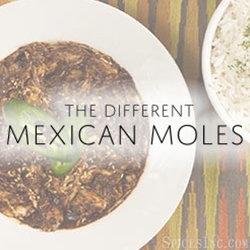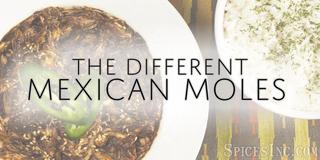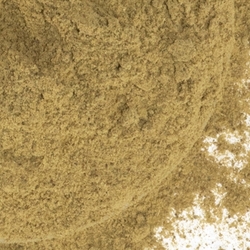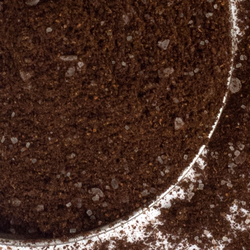The Different Mexican Moles

What Is a Mole?
The word mole, pronounced "MOH-lay" roughly translated means sauce or mix, depending on the context. This is a word that comes from the Nahuatl word for sauce, mōlli.
Moles are important in Mexican culture. There is even a phrase "ir a un mole" that means "to go where there is mole" and comes from the Mexican tradition of families using moles at big events. This phrase is often said as an indication that someone will be attending a wedding.
Because Mexican cuisine is so unique, each town may have its own different version of a mole that is also made the next town over with several different ingredients. Think of a mole more as an idea or concept, not necessarily a to the 't' recipe that needs to be strictly followed.
Where Does Mole Come From?
There is a little debate when it comes to the origin of mole. Mole has been around for quite a long time; it comes from the Nahuatl word mōlli, which means “milled” or “pounded”, and it’s the common name for a series of rich sauces that are often chile-based. Both Puebla and Oaxaca claim to be the birthplace of moles, and there are extremely well-known and much-loved moles that can be found in both regions. In addition, there are different mole styles and flavors all over Mexico, so the origin of the mole will probably always remain a mystery.
An amusing myth surrounds the origins of mole. As the legend goes, there was a group of Spanish nuns in the Convent of Santa Rosa that were getting ready to serve an archbishop but were short on supplies and unsure of what to feed him when he arrived. They threw everything they had—some chiles, some stale bread, some nuts, and chocolate, by mistake—into a pot to make a sauce and slaughtered the wild turkey in their yard to serve with this kitchen-sink sauce. The archbishop loved it and from that point forward, mole entered Mexico’s culinary sphere. This event reportedly happened in Puebla, meaning that they would be the birthplace of mole. Of course, Oaxaca has a similar origin story taking place in their part of the country. Some historians however think that moles were popular well into pre-Hispanic history in Mexico, dating all the way back to the time of the Aztecs, ruling out either place as the place of origin for the mole.
This charming story that tells of the miraculous advent of mole, with a culture-defining sauce coming together as the result of panicked ingredient tossing, is most likely folklore. What’s more likely is that mole is a true example of fusion cooking that exemplifies the way that cultures interact and influence one another. Moles can be incredibly complicated to make, taking several days of careful cooking and containing upward to 30 ingredients in a single sauce. Aztec cooks had established the culinary tradition of blending chiles and savory items like chocolate and tomatoes long before the Spanish had arrived, creating mōlli, mole in its original form. The Spanish, who were “dietary determinists” and believed in the superiority of their own food, brought all their culinary traditions and an impressively large amount of new ingredients with them as they came to settle what they called New Spain. One of the cooking methods they brought to the Americas involved making pureed sauces from nuts and seeds and fruit. But there’s another step. The Moors had occupied Spain since the year 711 A.D. and retained control there for 800 years. They were the ones who brought this sauce-making tradition to Spain, along with the use of sweet and aromatic spices like cinnamon and acidic things like lime. 800 years into an occupation, these sauces were endemic to the culture but in reality, a Moorish import. In short, today's modern version of mole has a Mexican base with European influences, and those influences have roots that reach back to Iran and North Africa. The Spanish nuns, who came to Mexico in the 17th century, may have played a part by helping to refine mole into the beautiful, thoughtfully prepared dish we know today, but it’s unlikely they stumbled upon a mole recipe on a wing and a prayer.
Types of Mexican Mole
- Manchamantel- the color of this intensely red mole comes from tomatoes, ancho chiles, and the grease of chorizo, a type of sausage. This mole is unique because it features plantains and pineapple in its ingredients list.
- Chichillo- a mole that begins with a homemade beef stock, chichillo is full of chiles that give it that signature spicy flavor. Usually dried chiles are used and they are rehydrated in the beef stock to allow for the most spiciness to come out.
- Verde- pepitas, parsley, and green chiles give this mole its distinct color and herbaceous flavoring. The mole verde is spicy thanks to jalapenos. You may also find tomatillos in this mole, which contribute even more to the green coloring and the delicious flavor of this mole.
- Negro- this mole may contain up to 36 ingredients and usually features a pig, turkey, or chicken head. This is a popular mole in America. You absolutely cannot forget about the dark chocolate or else it wouldn't be a negro mole! The steps taken to make this dish are often involved and time consuming, meaning this cannot be made quickly or mindlessly. Expect to dedicate a whole day to recreating this mole.
- Coloradito- a specialty mole served in Oaxaca, it is brick red in color and it is served over pork, beef, or chicken. It has mashed plantains in it as a thickener and it is often compared to the negro mole.
- Amarillo- a mole that could be compared to an Indian curry, this one is slightly less involved than other moles. Its name translates to "yellow" but it typically more orange in color. This mole is popular over chicken or meaty white fish and uses a milder light red guajillo chile to give color and spice to the mole.
- Mole Poblano- arguably the most popular mole outside of Mexico, especially in the United States, this mole is full of ingredients and like the mole negro, takes a very long time to make. It is thought to be one of the national dishes of Mexico. This is sometimes called "mole rojo" and it is often served with turkey at special events. You are more likely to find a mole poblano at a special event than you would the mole negro because it is slightly less time consuming and it has a flavor that almost everyone can agree upon. This is not an especially spicy mole, and it has a rich, deep flavor and color that is sure to stain your fingers as you're dipping tortillas in it.
What Are the Ingredients of a Mole?
Each ingredient in a mole can usually fit into one of these four categories- sweet, sour, chile, or thickener. Thickeners are not always things like arrowroot powder or cornstarch, sometimes they are ground nuts or mashed plantains. A mole has all these components and can be made with dozens of other ingredients that either fit into those four categories or fall outside of them. There is no specific set of ingredients for any mole, just bases that seem uniform so the other ingredients can be built around those bases. If chocolate is added to the mole, it goes in last. This is very important, because chocolate burns easily and can be quickly overcooked.
Even though chocolate is a common ingredient in moles now, it wasn't always. The Aztecs would have probably been thrown off by people adding chocolate to their moles. To the Aztecs, chocolate was a decadent treat reserved for the wealthy and for special occasions. Any uses outside of that were looked down upon, so they would not have been using it in everyday food like a mole.
Moles are great for parties, big events, and for experimenting with different ingredients. Mexico is the mecca of moles, so you can look to Mexican cuisine for the best variations of these delicious sauces. For the next big event in your life, give one of these incredible moles a try!
Read More
Intro to Authentic Mexican Cuisine
Mexican Spices, Seasonings and Chiles
8 Healthiest Cuisines in the World
What Is a Sofrito?




